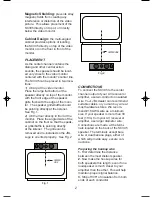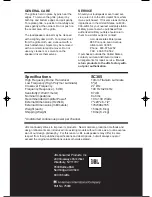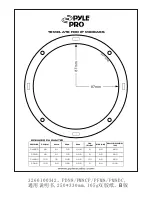
3
4. Twist each set of thin wires into a
tightly-bunched spiral.
5. At this point you need to identify a
visual difference between the two con-
ductors of each molded pair of speak-
er wire. Differentiating marks can be a
different color wire (copper or "silver");
a strand of yarn in one conductor; thin,
raised ribs on one part of the outer
insulation; or a printed "+" marking on
one of the insulators. It does not make
any difference which of the two
strands of wire go to (+) and (-) on the
speakers and amplifier, as long as
both speakers are connected identi-
cally. Push down on the button below
the terminal and insert the wire, or the
banana plug, through the hole (see
Fig. 3).
The red terminal on the loudspeaker
should be connected to the red or (+)
center channel connection terminal on
the AV receiver or amplifier, and the
black to the black or (-). Connecting
the loudspeaker in this manner
ensures that it will be in phase; that is,
work together rather than in opposition
to the left and right channel speakers.
Connecting loudspeakers out of phase
will not damage them, but will result in
less bass and poor imaging.
Using the controls on your center
channel AV receiver/amp, adjust the
center channel level (volume) control
so that the sound from the center
speaker is the same level
at your nor-
mal listening position, as the sound
from the left and right front speakers.
POWER HANDLING
Thanks to its high efficiency, the JBL
SC305 loudspeaker will produce reason-
able volume levels in a room of moderate
size with very little amplifier power.
However, using a small amplifier to obtain
the desired volume listening levels may
lead to overdriving the amplifier. This will
generate high distortion levels and may
cause damage to your loudspeaker. For
the best performance, an amplifier should
be selected with an output rating that is
greater than the maximum power that will
be used. This margin of reserve power will
ensure that the amplifier will not attempt to
deliver more power than its design allows.
However, the amplifier's power rating per
channel must not exceed the maximum
recommended amplifier power for that spe-
cific loudspeaker model. Please see the
specification section for details. Following
these guidelines will provide virtually distor-
tion-free sound reproduction and long loud-
speaker life.
TROUBLESHOOTING
The vast majority of new speaker "malfunc-
tions" end up being traced to connections
or switch settings. Check the following tips
first, before requesting service.
No sound at all or very faint sound from
the center channel speaker
1. Speaker wire has become disconnected.
2. One of the connections between sound
source and AV receiver/amp is faulty or
has become disconnected.
3. AV receiver/amp center channel mode
not selected. Please select a mode that
activates the center channel.
4. AV receiver/amp "audio direct" switch is
activated. This switch should be off to acti-
vate the 5 speaker surround mode.
5. Sound source (VDP, VCR,CD,cassette
deck, turntable) not turned on, not activat-
ed, not hooked up or not selected on AV
receiver/amp front panel.
Speaker plays at low volumes but shuts
off as volume is increased OR sound
turns on and off intermittently
A few strands of speaker wire may be
shorting out. Recheck the connections.
Recheck the impedance of the amp.
AV Receiver
Center
• •
(-) (+)
Center
Speaker
Blk Red
(-) (+)
• •
Fig. 3
JBL1044 7/27/98 2:16 PM Page 3






















